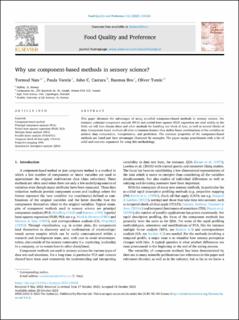| dc.contributor.author | Næs, Tormod | |
| dc.contributor.author | Varela, Paula | |
| dc.contributor.author | Castura, John C. | |
| dc.contributor.author | Bro, Rasmus | |
| dc.contributor.author | Tomic, Oliver | |
| dc.date.accessioned | 2023-11-20T12:27:01Z | |
| dc.date.available | 2023-11-20T12:27:01Z | |
| dc.date.created | 2023-11-01T12:48:22Z | |
| dc.date.issued | 2023 | |
| dc.identifier.citation | Food Quality and Preference. 2023, 112 1-18. | |
| dc.identifier.issn | 0950-3293 | |
| dc.identifier.uri | https://hdl.handle.net/11250/3103577 | |
| dc.description.abstract | This paper discusses the advantages of using so-called component-based methods in sensory science. For instance, principal component analysis (PCA) and partial least squares (PLS) regression are used widely in the field; we will here discuss these and other methods for handling one block of data, as well as several blocks of data. Component-based methods all share a common feature: they define linear combinations of the variables to achieve data compression, interpretation, and prediction. The common properties of the component-based methods are listed and their advantages illustrated by examples. The paper equips practitioners with a list of solid and concrete arguments for using this methodology. | |
| dc.language.iso | eng | |
| dc.title | Why use component-based methods in sensory science? | |
| dc.title.alternative | Why use component-based methods in sensory science? | |
| dc.type | Peer reviewed | |
| dc.type | Journal article | |
| dc.description.version | publishedVersion | |
| dc.source.pagenumber | 1-18 | |
| dc.source.volume | 112 | |
| dc.source.journal | Food Quality and Preference | |
| dc.identifier.doi | 10.1016/j.foodqual.2023.105028 | |
| dc.identifier.cristin | 2191026 | |
| dc.relation.project | Nofima AS: 202102 | |
| dc.relation.project | Norges forskningsråd: 314318 | |
| dc.relation.project | Nofima AS: 202103 | |
| dc.relation.project | Norges forskningsråd: 314111 | |
| cristin.ispublished | true | |
| cristin.fulltext | original | |
| cristin.qualitycode | 1 | |
